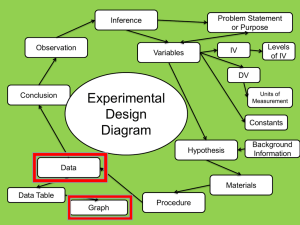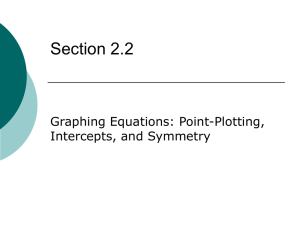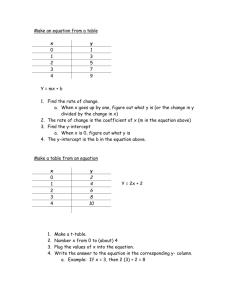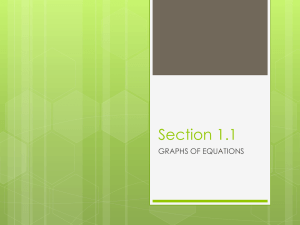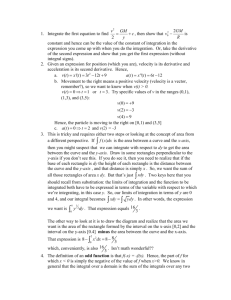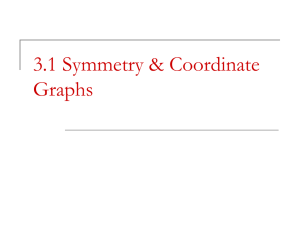Sec. 3.1 – Symmetry We`re going to be doing a lot of graphing in this
advertisement
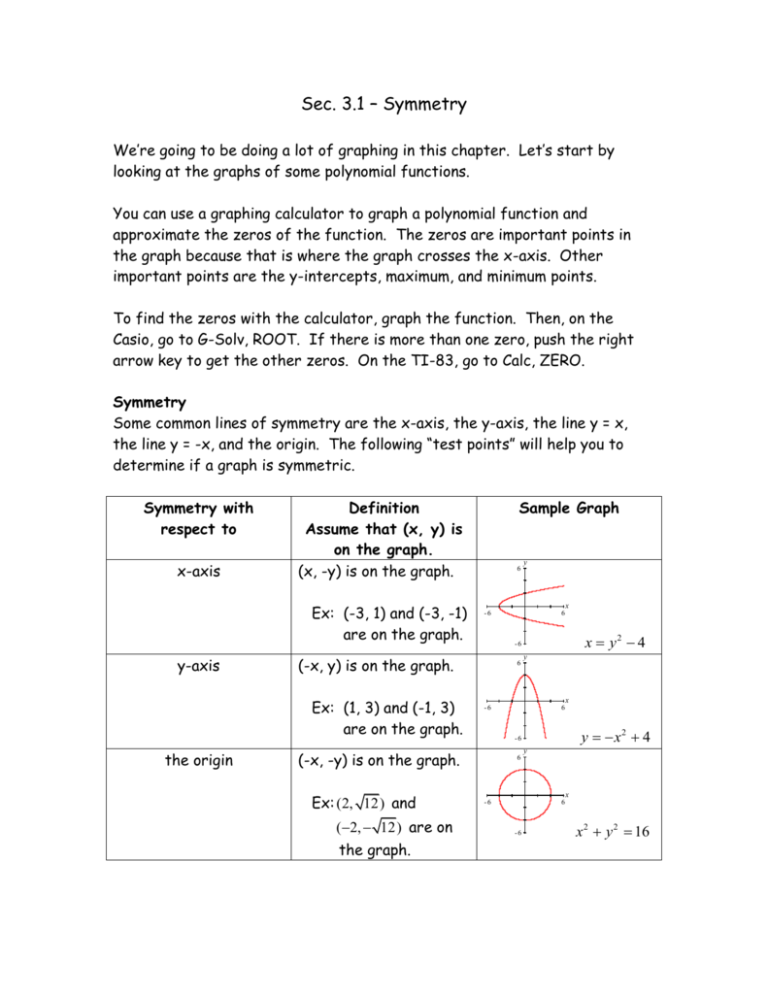
Sec. 3.1 – Symmetry We’re going to be doing a lot of graphing in this chapter. Let’s start by looking at the graphs of some polynomial functions. You can use a graphing calculator to graph a polynomial function and approximate the zeros of the function. The zeros are important points in the graph because that is where the graph crosses the x-axis. Other important points are the y-intercepts, maximum, and minimum points. To find the zeros with the calculator, graph the function. Then, on the Casio, go to G-Solv, ROOT. If there is more than one zero, push the right arrow key to get the other zeros. On the TI-83, go to Calc, ZERO. Symmetry Some common lines of symmetry are the x-axis, the y-axis, the line y = x, the line y = -x, and the origin. The following “test points” will help you to determine if a graph is symmetric. Symmetry with respect to x-axis Definition Assume that (x, y) is on the graph. (x, -y) is on the graph. Ex: (-3, 1) and (-3, -1) are on the graph. y-axis 6 x (2, 12) are on the graph. 6 x y2 4 -6 6 y x -6 6 y x2 4 -6 (-x, -y) is on the graph. Ex: (2, 12) and y -6 (-x, y) is on the graph. Ex: (1, 3) and (-1, 3) are on the graph. the origin Sample Graph 6 y x -6 6 -6 x 2 y 2 16 the line y = x (y, x) is on the graph. Ex: (2, 3) and (3, 2) are on the graph. the line y = -x 6 x -6 6 xy 6 -6 (-y, -x) is on the graph. Ex: (2, -3) and (3, -2) are on the graph. y 6 y x -6 6 -6 xy 6 Example 1: Determine whether the graph is symmetric with respect to the x-axis, the y-axis, the origin, the line y = x, and the line y = -x. y x 4 3x 2 8 x-axis: Does substituting (x, -y) produce the same equation? y x 4 3x 2 8 y x 4 3x 2 8 NO! The graph is not symmetric wrt the x-axis. y-axis: Does substituting (-x, y) produce the same equation? y ( x)4 3( x) 2 8 y x 4 3x 2 8 YES! The graph is symmetric wrt the y-axis. origin: Does substituting (-x, -y) produce the same equation? y ( x)4 3( x)2 8 y x 4 3x 2 8 NO! The graph is not symmetric wrt the origin. y = x : Does substituting (y, x) produce the same equation? x y4 3y2 8 NO! The graph is not symmetric wrt the line y = x. y = -x: Does substituting (-y, -x) produce the same equation? x ( y)4 3( y)2 8 NO! The graph is not symmetric wrt the line y = -x. A look at the graph confirms that the graph is only symmetric y 14 with respect to the y-axis. x - 10 -2 10 Example 2: Determine whether the graph is symmetric with respect to the x-axis, the y-axis, the origin, the line y = x, and the line y = -x. xy 6 x-axis: Does substituting (x, -y) produce the same equation? x( y ) 6 xy 6 xy 6 NO! The graph is not symmetric wrt the x-axis. y-axis: Does substituting (-x, y) produce the same equation? ( x) y 6 xy 6 xy 6 NO! The graph is not symmetric wrt the y-axis. origin: Does substituting (-x, -y) produce the same equation? ( x)( y ) 6 xy 6 YES! The graph is symmetric wrt the origin. y = x : Does substituting (y, x) produce the same equation? ( y )( x) 6 xy 6 YES! The graph is symmetric wrt the line y = x. y = -x: Does substituting (-y, -x) produce the same equation? ( y )( x) 6 xy 6 YES! The graph is symmetric wrt the line y = -x. A look at the graph confirms that the graph is symmetric with respect to the origin, the line y = x, and the line y = -x. 6 y x -6 6 -6 Even and Odd Functions A function is an even function if its graph is symmetric with respect to the y-axis. It has exponents that are all even. A function is an odd function if its graph is symmetric with respect to the origin. It has exponents that are all odd. Example 3: Determine if the following functions are even, odd, or neither. a) y x 2 2 6 y x -6 6 -6 The graph is symmetric wrt the y-axis, so the function is even. b) y ( x 2)2 6 y x -6 6 -6 The graph is not symmetric wrt either the y-axis or the origin, so the function is neither even nor odd. c) y x3 6 y x -6 6 -6 The graph is symmetric wrt the origin, so the function is odd. Example 4: Given point P, determine the coordinates of the point that is symmetric with respect to the x-axis, the y-axis, the origin, the line y = x, and the line y = -x. a) P(3, 4) b) (4, -8) x-axis: (3, -4) x-axis: (4, 8) y-axis: (-3, 4) y-axis: (-4, -8) origin: (-3, -4) origin: (-4, 8) y = x : (4, 3) y = x : (-8, 4) y = -x: (-4, -3) y = -x: (8, -4) Example 5: The graph below is a portion of a complete graph. Sketch a complete graph for each of the following symmetries: a) the x-axis, b) the y-axis, c) the origin, d) the line y = x, and e) the line y = -x. 6 y x -6 6 (The graph contains the point (3, -1). a) the x-axis. The graph needs to contain the point (3, 1). -6 6 y x -6 6 -6 b) the y-axis. The graph needs to contain the point (-3, -1). 6 y x -6 6 -6 c) the origin. The graph needs to contain the point (-3, 1). 6 y x -6 6 -6 d) the line y = x. The graph needs to contain the point (-1, 3). 6 y x -6 6 -6 e) the line y = -x. The graph needs to contain the point (1, -3). 6 y x -6 6 -6

